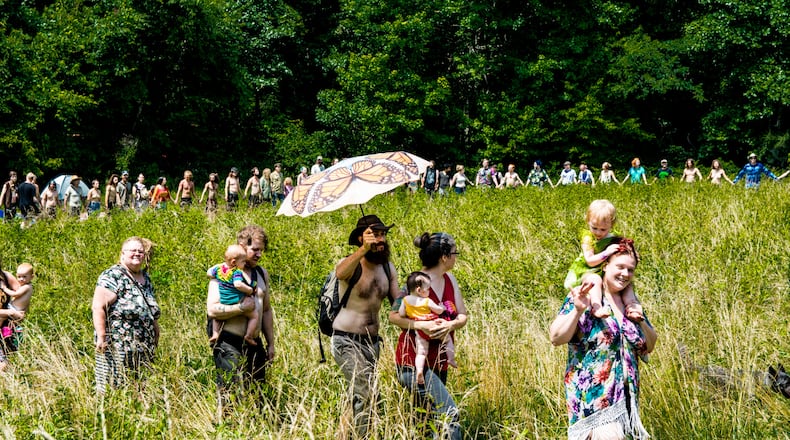The morning began with a circle of 2,500 adults holding hands in relative silence across the meadow at Chattahoochee-Oconee National Forest in Lumpkin County. Children formed another circle in the center as a sacred sound rose spontaneously through the crowd. For many of the self-proclaimed hippies, nudists, anarchists and iconoclasts attending the annual month long gathering of the Rainbow Family of Living Light, this circle — a prayer for world peace on Independence Day — is the high point.
But gatherers would soon learn that not everyone among them was at peace. Days later, a Florida woman, Amber Robinson, 18, was allegedly killed by Joseph Bryan Capstraw, 18, of Jacksonville, Fla., after the two hitchhiked together from the Georgia gathering. Capstraw, who confessed to killing Robinson in Elizabethtown, Ky., has been charged with murder.
“They mean well, but anytime you get 5,000 people, everybody is not going to be on the same page and you have some bad people in there,” said Steven Bekkerus, spokesman for the U.S. Forest Service, which has had more than 40 years of experience with Rainbow gatherings.
The tragedy has left some Rainbows pondering the future, including how to spread the vision and tradition of Rainbow gatherings to new generations. Some Rainbows are also concerned that these incidents may impact an already contentious relationship with local authorities in communities where the gatherings are held.
Since 1972, the Rainbows, a leaderless collective of individuals that evolved from the anti-war and hippie era of the 1960s, have been gathering in national forests across the country. Each year, a vision council scouts locations and decides which forest to visit next.
Stephen Wing, 61, of Atlanta, a Rainbow who attended his first gathering in 1981, was pleased to see the Rainbow Family come to Georgia. It was easier for him to attend the gathering, he said, but he also had some concerns.
“The success of it depends on having enough people who know how it works versus people there for the first time. Most of the experienced gatherers live out West and some in the Northeast. In this area, I knew we would get a lot of new people,” Wing said.
Credit: HANDOUT
Credit: HANDOUT
The “Summer of Love”-style gatherings are made up of a collection of camps and kitchens such as the Jesus Camp, Hare Krishna Camp, Instant Soup, Shanty Cakes and Kids Village. Thousands of individuals work together to set up the kitchens, filtration systems, latrines and medical centers that serve the needs of all attendees during their stay. Decisions are made by passing a feather to anyone who wishes to speak. There is drumming, music and singing. There are drugs, nudity and alcohol. There is poetry, prayer and positive vibes. It is all free. It is open to everyone. And no one is in charge.
Setup began on June 12. It was the first time the annual event has been held in Georgia, and its first time in the South since the 2012 gathering in Tennessee. While the U.S. Forest Service has experience with Rainbow gatherings, it is often a new and intimidating experience for residents in the surrounding communities.
North Georgia residents in several town hall meetings expressed concerns about traffic, crime and public disturbances. At those same meetings, Rainbow Family elders worried that law enforcement would be particularly harsh.
Lynn Cheramie, 58, a local resident and business owner in Dahlonega, said the stories on social media about trash left behind and the impact on the forest were disturbing. “I had an issue with the trash pickup, but even with that, still they didn’t tear anything down,” he said. “It won’t take long to rehab it. I think we got more financial benefit out of it than we did destruction of the forest.”
Several dozen Rainbow gatherers stayed behind cleaning up the area and aerating and reseeding the land. The trails are open, but the Forest Service issued an alert announcing the area near Bull Mountain where the Rainbow gathering took place is closed to camping until Sept. 1.
There’s a history of battles with the Forest Service over permits. Rainbows have refused to sign permits, contending they have no official leader. In 1997, the Forest Service formed a National Incident Management Team (NIMT) specifically to cover Rainbow Family national gatherings due to the large number of people who attend the event. The team works in conjunction with state, county and local law enforcement as well as other agencies and organizations.
Clashes with law enforcement also are characteristic of Rainbow gatherings. According to records provided to The Atlanta Journal-Constitution by the Lumpkin County Sheriff’s Office, there were 203 arrests from June 12-July 8, an uptick when compared to 116 arrests during the same time period in 2017; however, it was unclear how many of those arrests could be attributed to Rainbow gathering attendees. Citations issued during the time period included marijuana possession, traffic violations and using cellphones while driving.
But over the years, there have been far worse crimes. In 1980, two women attending the Rainbow gathering in Monongahela National Forest in West Virginia were killed. Their killer has never been found. More recently, a woman at the 2014 gathering in Uinta-Wasatch-Cache National Forest in Utah was arrested for stabbing a man at the campsite, and another woman was found dead outside the camp. In 2015, at a regional gathering in Florida’s Apalachicola National Forest, a Milledgeville man allegedly shot and killed another man after an argument.
>>Related: Man reported missing after attending Rainbow gathering is found
“One of the concepts of the Rainbow gathering is allowing people to be their full authentic selves. When you deal with people who have different cultural backgrounds, age groups, focuses and experiences, you get a whole different gamut of self-expression,” said Jasmine Turner, 41, of Atlanta, who attended her first gathering in July.
Turner hoped the recent tragic incident would help inspire change. “Because most people who attend are concerned about the well-being of others, that should be inspiration to say what can we do to inspire people who want to make better and healthier choices, not just for their sake but for the sake of the reputation of the event,” she said.
Rainbow elders have also sensed a shift. In recent years, some Rainbows have noticed that the crowd is less focused on the spiritual aspect and more into partying, promoting their politics or something else altogether. As many of the original Rainbows grow older and less mobile, it has become even more important for newcomers to understand and carry forth the spirit of the gathering.
Zashe Demings, 22, of Atlanta, who was one of those first-timers, said she met many people who were eager to talk about how the Rainbow gathering started. They gave her tours of the campsite and showed her what Rainbow gathering was all about. “Because it was my first time, I didn’t know what to do. I was kind of like, let’s walk around and see,” she said. “The next go-round, I will definitely help out in any way I can.”
For any new attendee, there is a learning curve, but there must also be a willingness to be taught. “I was a second-generation Rainbow and the vision was so clear. Right now, it is tenuous whether the vision will be carried on intact,” Wing said. “The future is unknown and we have enough forces trying to stamp it out.”
About the Author
Keep Reading
The Latest
Featured



